Potřebujeme váš souhlas k využití jednotlivých dat, aby se vám mimo jiné mohly ukazovat informace týkající se vašich zájmů. Souhlas udělíte kliknutím na tlačítko „OK“.
ASTM E1590-13
Standard Test Method for Fire Testing of Mattresses
Automaticky přeložený název:
Standardní zkušební metoda pro požární zkoušky matrací
NORMA vydána dne 1.4.2013
Informace o normě:
Označení normy: ASTM E1590-13
Poznámka: NEPLATNÁ
Datum vydání normy: 1.4.2013
Kód zboží: NS-42285
Počet stran: 24
Přibližná hmotnost: 72 g (0.16 liber)
Země: Americká technická norma
Kategorie: Technické normy ASTM
Kategorie - podobné normy:
Anotace textu normy ASTM E1590-13 :
Keywords:
calorimetry, carbon dioxide, carbon monoxide, fire, fire-test-response, heat release, ignition, mattress, oxygen consumption, smoke obscuration, toxic combustion gases, ICS Number Code 13.220.40 (Ignitability and burning behaviour of materials and products), 97.140 (Furniture)
Doplňující informace
| Significance and Use | ||||||||||||||||||||||||||||||||||||||||||||
|
5.1 This test method provides a means of measuring a variety of fire-test-response characteristics resulting from burning a test specimen, mattress or mattress with foundation. After ignition using a propane gas burner, the test specimen is permitted to burn freely under well-ventilated conditions. The most important fire-test-response characteristic measured in this test method is the rate of heat release, which quantifies the intensity of the fire generated. 5.2 The rate of heat release is measured by the principle of oxygen consumption. Annex A3 discusses the assumptions and limitations. 5.3 This test method also provides measures of other fire-test-response characteristics, including smoke obscuration (as the rate of smoke release, total smoke released, or optical density of smoke), combustion gas release (as concentrations of combustion gases), and mass loss, which are important to making decisions on fire safety. 5.4 In the majority of fires, the most important gaseous components of smoke are the carbon oxides, present in all fires. They are indicators of the toxicity of the atmosphere and of the completeness of combustion. Measurement of concentrations of carbon oxides are useful for two purposes: (5.5 The type of ignition chosen (flaming source) is common in both accidental and intentional fires in public occupancies. The test method is thus applicable to mattresses in public occupancies. Such facilities include, but are not limited to, health-care facilities, old age convalescent and board and care homes, and college dormitories and residence halls. 5.6 One of the following three configurations is to be used in this test method: 5.6.1 Test Configuration A—A test room with the following dimensions: 3.66 by 2.44 by 2.44 m (12 by 8 by 8 ft) high. 5.6.2 Test Configuration B—A test room with the following dimensions: 3.66 by 3.05 by 2.44 m (12 by 10 by 8 ft) high. 5.6.3 Test Configuration C—An open calorimeter (or furniture calorimeter). 5.7 Rooms of other dimensions are acceptable where it has been shown that equivalent test results are obtained. 5.8 Measurements in the three test configurations listed in 5.6 have been shown to give similar results for heat release in the duct, and mass loss, up to a rate of heat release of 600 kW (1).9 5.9 Measurements of temperatures, gas concentrations, and smoke obscuration in the room are dependent on room size. 5.10 This test method has been designed to provide details for the means to build and operate equipment capable of running tests as required by CA TB 129. However, this test method is more general than that technical bulletin. 5.11 Studies on the flammability performance of mattresses indicate that bench scale fire tests are useful for preliminary evaluations of component materials for substitution purposes (see Appendix X3). 5.12 Limitations: 5.12.1 This test method is not applicable to ignition by cigarettes, or by any other smoldering source. 5.12.2 The ignition source in this test method is a flaming source, and it has been shown that mattresses, particularly in public occupancies, are involved in fires with flaming ignition sources. Moreover, this particular ignition source has been shown to be able to provide a distinction between different kinds of mattress items. However, the fraction of actual flaming mattress fires occurring with ignitions more or less intense than that used here is not known. 5.12.3 It is not known whether the results of this test method will be equally valid when a mattress is burned under conditions different from those specified. In particular, it is unclear whether the use of a different ignition source, or the same ignition source but having a different duration of flame exposure or a different gas-flow rate, will change the results. 5.12.4 The value of rate of heat release corresponding to the critical limit between propagating mattress fires and non-propagating fires is not known. 5.12.5 As yet, there is not a known direct correlation between smoke obscuration or smoke toxicity measurements in the exhaust duct and overall fire hazard. |
||||||||||||||||||||||||||||||||||||||||||||
| 1. Scope | ||||||||||||||||||||||||||||||||||||||||||||
|
1.1 This is a fire-test-response standard. 1.2 This test method provides a means of determining the burning behavior of mattresses used in public occupancies by measuring specific fire test responses when the test specimen, a mattress or mattress with foundation, is subjected to a specified flaming ignition source under well ventilated conditions. 1.3 This is a test method for mattresses or mattresses with foundations. 1.4 Test data are obtained describing the burning behavior, following application of a specific ignition source, from ignition until all burning has ceased, a period of 1 h has elapsed, or flashover appears inevitable. 1.5 This test method does not provide information on the fire performance of mattresses under fire conditions other than those specified in this test method. In particular, this test method does not apply to smoldering ignition by cigarettes. See 1.6 The rate of heat release of burning test specimen is measured by an oxygen consumption method. See 1.7 Other measurements are the production of light-obscuring smoke and the concentrations of certain toxic gas species in the combustion gases. See 5.12.5 for further information. 1.8 The burning behavior is documented visually by photographic or video recordings. 1.9 Use the SI system of units in referee decisions; see IEEE/ASTM SI-10. The units given in parentheses are for information only. 1.10 This standard is used to measure and describe the response of materials, products, or assemblies to heat and flame under controlled conditions, but does not by itself incorporate all factors required for fire hazard or fire risk assessment of the materials, products or assemblies under actual fire conditions. 1.11 Fire testing is inherently hazardous. Adequate safeguards for personnel and property shall be employed in conducting these tests.. 1.12 This standard does not purport to address all of the safety concerns, if any, associated with its use. It is the responsibility of the user of this standard to establish appropriate safety and health practices and determine the applicability of regulatory limitations prior to use. |
||||||||||||||||||||||||||||||||||||||||||||
| 2. Referenced Documents | ||||||||||||||||||||||||||||||||||||||||||||
|
Podobné normy:
Historická
15.7.2013
Historická
1.10.2013
Historická
1.4.2008
Historická
1.4.2008
Historická
1.4.2014
Historická
1.4.2013



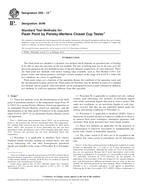 ASTM D93-13e1
ASTM D93-13e1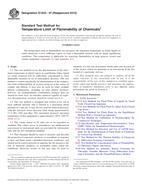 ASTM E1232-07(2013)..
ASTM E1232-07(2013)..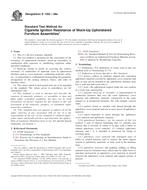 ASTM E1352-08a
ASTM E1352-08a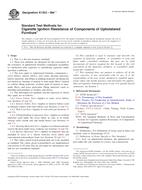 ASTM E1353-08ae1..
ASTM E1353-08ae1..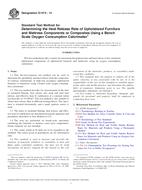 ASTM E1474-14
ASTM E1474-14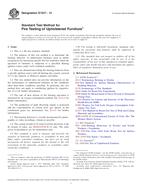 ASTM E1537-13
ASTM E1537-13
 Cookies
Cookies
